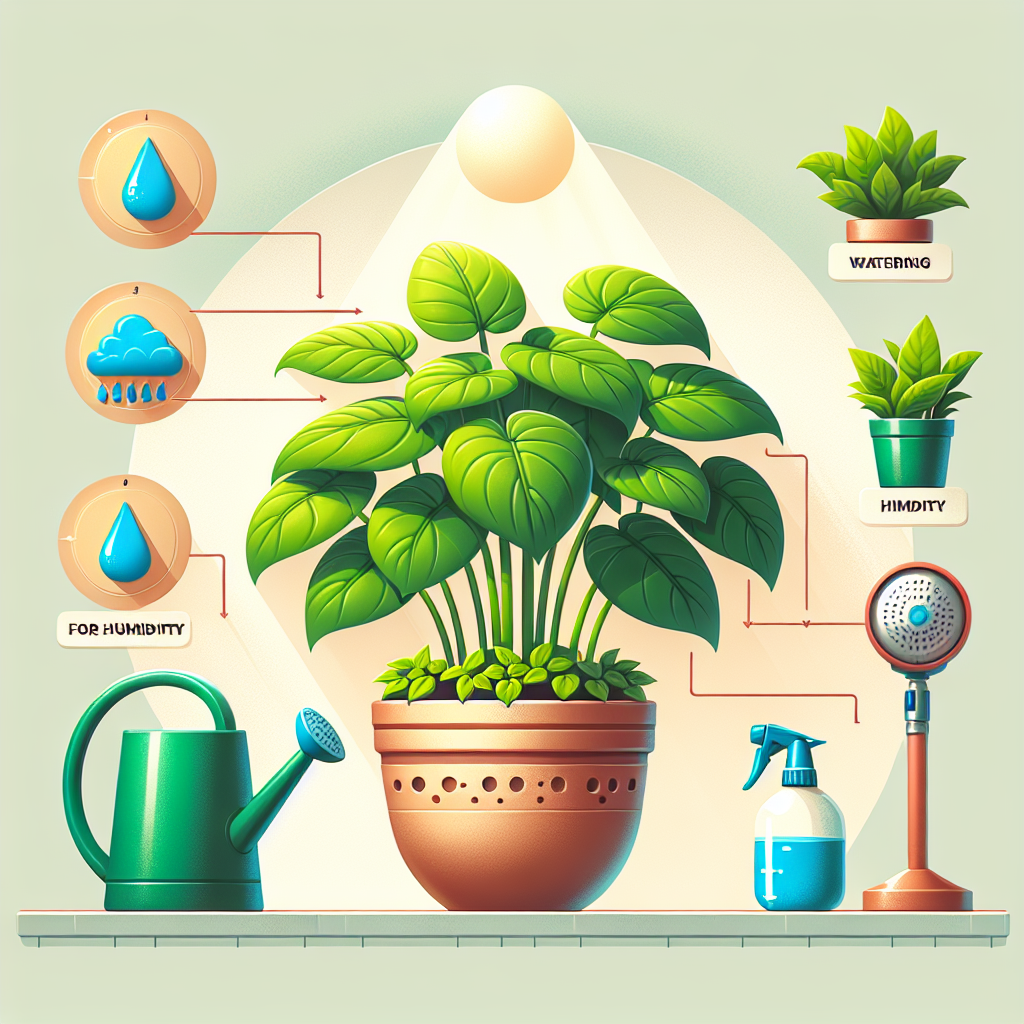The Beginner’s Guide to Caring for a Swiss Cheese Plant
Updated June 20, 2024 at 12:17 pm

Overview of Swiss Cheese Plant Care
- Pet Friendly: It’s important to note that Swiss Cheese Plants are toxic when ingested, so they may not be the best option if you have curious pets around.
- Light Requirements: These plants thrive in bright, indirect sunlight. Positioning them near a window with a sheer curtain would be ideal.
- Watering: They like their soil to stay slightly moist. It’s usually best to water them once a week, but ensure the top inch of soil is dry before watering again.
- Humidity: High humidity levels mimic their natural tropical habitat, so a humidity level of 60% or above is perfect.
- Temperature: Aiming for a temperature range between 60°F and 85°F (16°C-29°C) will keep your plant comfortable.
- Difficulty: Caring for a Swiss Cheese Plant is generally easy, which makes it great for beginners. However, attention to its environmental needs is key.
What Type of Pot Should I Use for a Swiss Cheese Plant?
If you’re starting your Swiss Cheese Plant journey, getting the right pot is crucial. The container should have ample drainage holes to prevent water from sitting at the bottom, which could lead to root rot – a common issue for many houseplants. Terra cotta pots are fantastic options as they are porous and allow the soil to dry out more evenly than plastic pots. A stylish and popular choice is the La Jolie Muse Plant Pot. It has a modern design with a drainage hole and a rubber plug. Reviews suggest that it’s not only functional but also adds a chic touch to indoor decor.
Find This and More on Amazon
How Often Should I Repot My Swiss Cheese Plant?
Swiss Cheese Plants are pretty fast growers, and they might need to be repotted every 18-24 months. It’s best to repot during the growing season, which is spring or summer. Remember, these plants can get quite large, so choose a new pot that’s about 2 inches larger in diameter than the current one. It gives the roots plenty of room to spread out. While repotting, it’s a good time to inspect the roots for any signs of rot or disease and trim as necessary. Using a high-quality potting mix like Miracle-Gro Indoor Potting Mix can provide the right balance of drainage and support for your Swiss Cheese Plant’s growth.
Choosing the Right Soil for Your Swiss Cheese Plant
Selecting the proper soil for your Swiss Cheese Plant is like picking out a good pair of shoes—it needs to fit well for optimum comfort and growth. A well-draining potting mix is essential, and it might be beneficial to mix in some peat moss, perlite, or vermiculite to promote aeration. Reviews of the FoxFarm Ocean Forest Potting Soil highlight its optimal pH balance that helps with strong root development and vigorous growth. Just remember not to pack the soil too tightly around the plant; it loves a little breathing room!
Find This and More on Amazon
Understanding Light Requirements for a Thriving Swiss Cheese Plant
Light is like a meal for your Swiss Cheese Plant. Without it, the plant would starve. Yet too much direct sunlight can be akin to overeating, which could scorch its leaves. Therefore, it is recommended to place your Swiss Cheese Plant in a room where soft, indirect light pours in. If you feel your space isn’t bright enough, you might want to opt for grow lights. A widely praised product by plant enthusiasts is the GE BR30 Full Spectrum LED Grow Light. It’s said that users have noticed significant improvements in plant health and growth when using this light, especially during the dark winter months.
Find This and More on Amazon
Watering Tips for Optimal Swiss Cheese Plant Health
When you think of tropical rainforests, moisture comes to mind, right? Your Swiss Cheese Plant originates from this environment, so watering plays a crucial role in mimicking its natural habitat. Too little water and the leaves will droop, signaling thirst. Conversely, too much water can lead to yellowing leaves and a weakened plant. A rule of thumb is to wait until the top inch of soil is dry before watering again. An excellent tool to help you out is a soil moisture meter, like the XLUX T10 Soil Moisture Sensor Meter. Reviewers often mention how this simple device has helped prevent over-watering, keeping their Swiss Cheese Plats lush and thriving.
Find This and More on Amazon
Recognizing and Solving Common Swiss Cheese Plant Pests and Problems
With its large, fenestrated leaves, the Swiss Cheese Plant is inviting not just to admirers but, unfortunately, to pests as well. Common culprits include spider mites and mealybugs, which can sap the life from your plant if left unchecked. Keeping an eye out for tell-tale signs of infestation, such as small webs or white cottony substances, can save your plant from significant damage. For organic solutions to pest woes, consider using neem oil spray. Many gardeners applaud the Bonide Neem Oil Fungicide Miticide Insecticide for its effectiveness against a range of houseplant pests. Apply as directed, and remember that early detection is vital.
How to Promote Healthy Growth and Leaf Development
A Swiss Cheese Plant’s distinctive look comes from its heart-shaped leaves with natural holes, known as fenestrations. For robust leaf development that culminates in these signature holes, your plant will need the right nutrients. Slow-release fertilizers can be your best friend here. Osmocote Smart-Release Plant Food is a popular choice that receives high marks for its ease of use and effectiveness in providing a steady supply of essential nutrients. Taking care not to over-fertilize, especially during the dormant winter months, will support healthy growth and prevent nutrient burn.
Maintaining the Perfect Humidity for Your Swiss Cheese Plant
As we’ve touched on earlier, the Swiss Cheese Plant thrives in a humid environment, one that reminds it of its tropical origins. Achieving this indoor may seem daunting, but with a little creativity, it can be simple. Grouping your plants together or placing a small humidifier nearby can provide the necessary moisture in the air. Another trick is to use a pebble tray filled with water under the plant’s pot to increase the surrounding humidity as the water evaporates. An excellent choice for an ultrasonic humidifier is the Pure Enrichment MistAire Ultrasonic Cool Mist Humidifier. Users have praised this humidifier for its quiet operation and the notable difference it made in their plant’s health and appearance.
Find This and More on Amazon
Thoughtful Pruning and Training for an Attractive Swiss Cheese Plant
Everyone loves a well-kept Swiss Cheese Plant with its unique leaf fenestrations. To maintain this aesthetic, thoughtful pruning and training of the plant are necessary. Trimming off any yellow or damaged leaves can promote new growth, and using a moss pole or other support can help your Swiss Cheese Plant reach its full potential in form. The process of training involves gently tying the stems to the support structure as it grows. A reliable product for plant training is the VELCRO Brand ONE-WRAP Garden Ties. Theres consensus among gardeners that these adjustable and reusable ties are gentle on the stems and offer an easy way of guiding the plant’s growth without damaging it.
Find This and More on Amazon
Creating the Right Environment for a Swiss Cheese Plant
Now that we’ve covered the essentials of watering, lighting, and soil requirements, let’s talk about the overall environment. Your Swiss Cheese Plant won’t just survive but will flourish if you recreate a bit of its natural habitat at home. A stable environment without drafts, sudden temperature changes, or direct heat sources can do wonders. Luckily, these plants are quite adaptable and can still thrive even if conditions aren’t perfect. It’s about finding a balance that works for both you and your green companion.
Swiss Cheese Plant Propagation: Expanding Your Collection
Once you’ve mastered the care of your Swiss Cheese Plant, why not expand your collection by propagating it? It’s a rewarding process and relatively simple. You can take stem cuttings with a node and aerial root, place them in water or moist potting soil, and wait for roots to develop. In a few weeks, with proper care, you should see signs of growth. For rooting, Garden Safe TakeRoot Rooting Hormone is often recommended by plant enthusiasts. It’s touted for improving the chances of successful propagation and stimulating healthy root development.
Find This and More on Amazon
Final Thoughts on Caring for Your Swiss Cheese Plant
In conclusion, taking care of a Swiss Cheese Plant is about providing a stable, suitable environment where it can thrive. Ensure proper lighting, choose the right soil, water appropriately, maintain humidity, and protect it from pests. Combine these factors with a touch of love and regular attention, and you’ve got all the ingredients for a happy, healthy Swiss Cheese Plant that will beautify your home for years to come. Just like with any plant, there are learning curves, and experience will be your best teacher. Enjoy the journey of growing your Swiss Cheese Plant!
Shop more on Amazon

